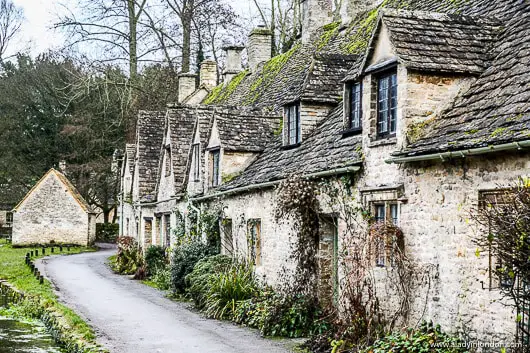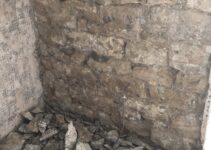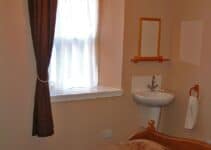Living in a cottage can be great for plenty of reasons, but their insulation is often a big downside. While traditional solid stone walls are good for keeping heat in, you might have noticed that your cottage’s floor isn’t as effective.
So, in this article, we’ll cover how to insulate a cottage floor. The best method will depend on the type of floor you have and how much work you’re willing to do.
We’ll cover these aspects briefly before moving on to the solutions.

Why are Cottage Floors so Cold?
Cottage floors are so cold because they either have a cavity underneath or they’re built directly onto packed earth.
Both of these suck heat out of the building due to normal heat transfer. Also, if your cottage floors are stone or tile, they’ll feel cooler than carpet or wood anyway because they’re better conductors of heat.
It’s fairly common for older cottages to have floors built directly onto the ground. Although soil is a poor conductor of heat (i.e., a good insulator), the main issue here is damp.
Moisture will improve the thermal conductivity of stone and soil, meaning they’ll suck more heat out of your cottage.
If your cottage has beams supporting the floor, there’s likely a crawl space-style gap underneath separating them from the earth.
While this can help combat rising damp, it’s not great for insulation. Heat can escape through gaps in the flooring into the cavity, making the room feel colder.

In short, cottage floors are so cold because they’re not well designed by modern standards. Many cottages were built before modern insulation materials and building techniques were invented, so builders were just doing the best they could with what they had.
Plus, other aspects of home maintenance have changed. First, many of the paints and insulation materials we use prevent traditional building materials from “breathing” or transferring moisture.
As mentioned, this can affect thermal conduction.
Second, old houses would have fires lit almost constantly. This would obviously heat the home but also reduce moisture levels in the air and improve airflow.
While they would’ve still been cold in the winter, a cold floor wouldn’t have been as noticeable.
How to Insulate a Cottage Floor No Foundation
If your cottage doesn’t have a foundation, you’ll need to approach floor insulation very carefully. It’s more common than you might think for older buildings to not have foundations.
Sufficiently thick stone walls can bear the building’s load without any issues, provided they’re on settled ground.
However, replacing the existing floors could undermine the walls and cause structural issues. As such, you’ll want to speak to an architect and structural engineer, who will probably suggest underpinning.
That said, the basics of insulating a cottage floor with no foundation would be:
· Rip up the existing floor, which is likely built directly on packed earth.
· Install a damp-proof membrane. This prevents moisture from seeping up into the subfloor, which will cause damage and affect your insulation.
· Add insulation materials. The most suitable material will depend on your needs, but could include rigid insulation boards (such as Kooltherm) or breathable wood fibre.
· Onto this, you’d fit the new floor. This’ll usually involve new battens and chipboard as a surface for the actual flooring material.
Bear in mind that insulating a floor in this way will take up a bit more room than the existing flooring. You should expect to lose 75-100mm from your headroom in the space.
Although you could probably reduce this by playing around with materials, the setup suggested above will provide a good combination of insulation and damp-proofing.
You should always aim to use breathable materials. That said, most damp-proof membranes (also known as vapour barriers) are impermeable.
They’re often sheets of plastic but some can include foil or other materials. Provided there’s sufficient breathability between the floor, subfloor and insulation, this should be enough.
How to Insulate a Cottage Floor on Piers
Building on piers means using vertical pillars to separate the walls and floor from the earth. They also help spread the load and create an air barrier between the ground and the bottom of the building.
Piers obviously help avoid the worst problems associated with damp but don’t do loads for insulation.
On top of the piers will be wooden beams, onto which your subfloor will be built.
Depending on what’s happened to your cottage in the past, previous owners may have exposed the subfloor in an effort to get a “rustic” look. What many might not realise is that this makes the room really cold.
So, what’s the best way to insulate a cottage floor on piers?
There are 3 options for how to insulate a cottage floor on piers, all of which require removal of the subfloor to expose the crawlspace and beams.
Your options are spray foam insulation, board insulation, and rolls or batts.
Let’s cover each option in more detail to understand how you’d use them.

Spray Foam Insulation
Spray foam insulation is pretty self-explanatory. It’s sprayed as a liquid, which expands and dries.
You’d apply this directly into the crawlspace to fill the gap and create a sufficient barrier between the floor and the earth.
A similar option is blown-in insulation. Rather than spraying an expanding liquid, this is applied as tiny pieces of fibreglass insulation.
To apply this, you’d want to leave the subfloor in place to contain the product and allow it to properly fill the space.
Both options work pretty well using the basic principle of insulation. In short, they trap a lot of air, which is a poor thermal conductor.
This helps reduce heat transfer between your floor and the earth.
You’ll want a professional to install blown-in insulation, and possibly spray foam. They need specialist equipment, and it’s much easier to get someone to do this for you.
Foam Board Insulation
This is another self-explanatory option. Rather than soft insulation materials, it consists of rigid boards of foam. The insulation principle is the same: it has lots of holes that trap air and reduce heat transfer.
You can install foam board insulation onto the existing beams, either on top of or below the subfloor. It won’t make much difference either way.
Ensure the boards are fitted close together and secured with caulk and tape.
Fibreglass Rolls or Batts
You’re probably most familiar with fibreglass batt insulation, as this is what many people install in their attics. They’re less dense than foam boards but more dense than blown-in insulation.
Foam rolls are perhaps the easiest DIY option, as you just need to unroll them and fit them into the crawlspace.
How to Insulate a Cottage Floor from Below
As mentioned, cottage floors built on piers will need the crawlspace insulating. Generally, this’ll mean ripping up the existing floor, which is expensive and takes a lot of time.
So, how can you insulate a cottage floor from below?
The easiest option for how to insulate a cottage floor from below is to use blown-in or spray foam insulation.
These options don’t require much access to the underfloor because you can just insert a nozzle and get going. Other options like batts or boards need lots of access, if only for the size of the material.
That said, you’ll have a lot more flexibility by removing existing flooring to access the subfloor or crawlspace from above.
If the current floor is wooden floorboards, you can usually remove these with a bit of care. Of course, removing tiles or stone intact is a bit more difficult.
But what about insulating the upper floor of your cottage? You should have a bit more flexibility doing it from below, as this’ll mean insulating a ceiling instead of a floor.
If you have access to the ceiling beams, install foam batts or rigid board between them. You should fit a new ceiling if using batts, but it’s not as necessary for boards (which you can just paint over).
Best Way to Insulate Under Cottage
The best way to insulate under cottage is to remove the existing flooring. This method works for floors built on packed earth and piers and gives you more flexibility over what insulation materials you use.
Rigid foam insulation is perhaps the best option material-wise. Fibreglass and mineral wool are both cheaper but can retain moisture, leading to damp.
Provided you’ve installed a damp-proof membrane, this should be less of a problem. Rigid board insulation, though, doesn’t retain any moisture.
However, choosing the best material and installation method will depend on your budget, level of knowledge, and the property itself.
For example, fibreglass is the least expensive option but has downsides. Rigid boards are more effective but take more effort to install.
Then you must consider whether you’re renovating a listed property, which requires extra permission. Also, if you’re not planning a major renovation, ripping up the existing floor (and possibly the subfloor) is a lot of work to install insulation.
Unless you’re familiar with floor renovations and insulation materials, it might be best to speak to a professional.
Start with a flooring contractor, as they’ll know about the best materials and different floor constructions. But, as mentioned, you might need to bring in a structural engineer depending on the age of your cottage and its condition.
Final Thoughts
Hopefully, you’ve now got a better idea of how to insulate a cottage floor. The specific method and materials will depend on the age, condition and construction of your cottage.
As such, calling a professional will be in your best interest, especially for old buildings.
After all, you don’t want to undermine the walls by ripping out the floor!



